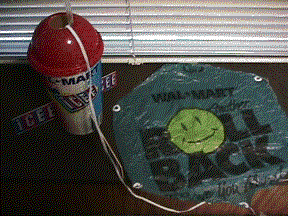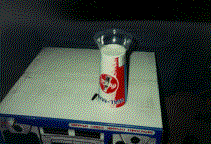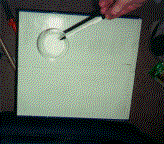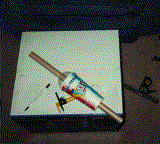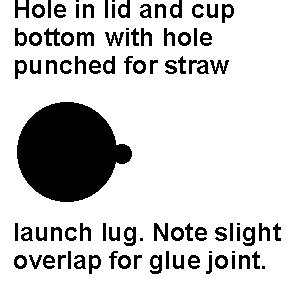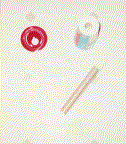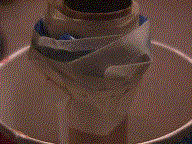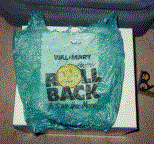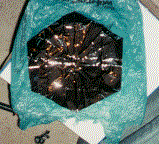| Manufacturer: | Scratch |
Emerging from the wastes of the world's largest retailer....
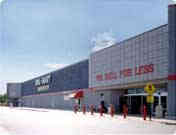
A supernatural occurrence?
A force for good?
A mutated FREAK defying all the laws of man and nature?
At first glance a tasty treat,

then it roars into the sky.
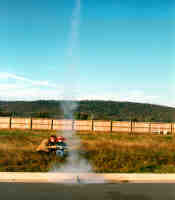
It can only be...
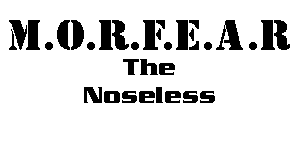
(Miracle of Refreshment From Easily Available Recyclables)
Overview:
M.O.R.F.E.A.R is a unique rocket without a nose cone. I was trying to come up
with a "found parts" rocket when I saw a cup sitting inthe drink
holder of my mini-van. Heyyyy!! Now, I need something more orginal thanthat. I
don't want to fly it upside down... I wonder how the domed lid icee cupswould
do? It turned out that the hole in the lid of the 20oz. Wal-Mart Icee cupis the
exact outside diameter of a BT-50. I was having trouble figuringout how to get
the lid off for recovery deployment when it came to me. Don't take thelid off
at all, just blow it out the hole. Since it's a Wal-Mart cup,a blue bag
parachute was the only real choice. M.O.R.F.E.A.R. flew on 4/1at the NWARS
launch. The instructions will be complete as soon as I get film with
theconstruction photos back from Wal-Mart.
Parts List:
1 - 20 oz. ICEE cup with domed lid and straw
1 - blue plastic Wal-Mart bag 1 - 7 11/16" BT-50
1 - 3" BT-20
2 - CR-2050
1 - Engine Hook
1 - 1/16" balsa sheet
1 - spray paint of the "flavor" of your choice
6 - Paper reinforcing rings
1 - Shock Cord Elastic
1 - Shroud (suspension) line thread
1oz Plasticine Clay
White Glue (plastic Norbond type preferred)
Gel type CA glue
Access to a color printer
A single hole hole-punch.
Assembly Instructions:
Remove ICEE contents from cup. (delicious) Thoroughly rinse cup, straw, and
lid. Use the lid to create a hole in the center or the bottom of the cup. Place
the small end of the domed lid inside the lip on the outside of the bottom of
the cup. It should nestle so that a circle can be traced on the center of the
bottom of the cup. Cut small and sand out.
Advanced note: I used an Olfa circle cutter after marking the circle. I found
the center of the circle by marking a chord and constructing a perpendicular
bisector. I marked another chord and constructed another perpendicular
bisector. The intersection of the two bisectors is the center of the circle. I
know, I'm a big ol' math geek. The Olfa cutter worked beautifully making
several light passes.
Place lid on cup and insert BT-50 through holes in lid an cup. Mark tube by allowing tube to rest on the same surface as the cup and mark tube flush with the lid. This allows the tube to extend past the bottom of the cup to the length of the lip. Cut tube to length. This was 7-11/16" for me.
Assemble and install the BT-20 motor mount and rings in the BT-50 tube. This is just like every other 18 mm motor mount you've installed. If you can't do this successfully, go build some kits and come back to this project later.
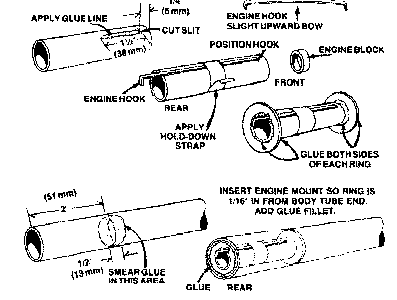
Use single hole punch to punch holes in the lid and in the bottom of the cup. The punched hole should slightly overlap the large hole for the BT-50.
Mark BT-50 tube lengthwise for entire length with door jamb. Location is not critical. This for the straw launch lug. I prefer my launch lugs to be 90-180º away from the engine hook. This is left up to you. If you are using a straw with a "spoon" on one end, I would recommend that the spoon go below the rocket (on the end with the motor mount). I have no flight data to support this. <g> Glue the straw along the line marked on the BT-50 tube. One end of the straw should be flush with the end of the BT-50 containing the motor mount (rear). The straw should extend past the front of the BT-50.
Spray paint the inside of the domed lid. It is very important that it be
clean and dry. Two coats of cheap Wal-Mart spray enamel should do it.
In the spirit of the thing, try and match the color to your favorite ICEE
flavor. You will note that mine is Minute Maid® Cherry.
Snap fit cup and lid (do not glue). Align small, punched holes and insert tube and straw assembly. Align rear of tube and straw assembly with lip on the rear of the cup. The engine hook should protrude below the lip and the top of the tube should be flush with the hole in the lid. The straw should protrude beyond the lid. Using gel CA, glue the tube and straw to the cup only. *DO NOT* glue the lid to the cup or the tube to the lid. If you did a particularly neat job of cutting the hole in the cup, you may need to lightly sand away some wax from the hole to get the CA to stick.
Cut 3 fins from balsa using the pattern.
Sand edges of fins to match.
Laminate fins with paper cutouts from this template. Use spots of white glue
thinned and spread with a wet finger to affix
paper laminates. I
used Norbond® brand glue. It is used to glue the first page of a book to
the cover and is made to not warp paper. Trim paper to balsa. I used a color
laser printer to print out the laminates. I imagine that color inkjet printers
would be OK if allowed to dry sufficiently and if the glue were not too thin or
too wet. Email me and I will print
and mail (flat) the 8.5x11" color sheet with the fin laminate printout for
a $5 donation to NWARS.
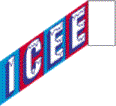
Measure the base of the cup for fin placement. My cup base is 62 mm in diameter. That gives it a circumference of (62 x 3.14) 194.5 mm. The fins should be spaced just under 65 mm apart. I cut a thin (.5 cm wide) strip of paper and wrapped it around the base of the cup. I marked the overlap and then marked off on the cup the increments where each fin should go. I was able to conveniently align one fin with a vertical mark on the cup for easy placement. Lightly mark the cup with a pencil for fin slots. The slots should be 38 mm long. The slots should be measured from the bottom of the cup which is 10 mm above the edge of the lip. Use a door jamb for vertical alignment. Use caution not to align a fin with the launch lug straw. I now have a fin wrapper pattern for M.O.R.F.E.A.R. I don't think that it will be as good as one that you make yourself.
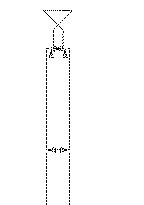
Cut fin slots along marks using a very sharp hobby knife so as not to bend paper cup. Start at the top of the slot and cut down to the bottom of the cup but do not cut through the bottom of the cup. Widen the fin slot with sandpaper, hobby knife or dremel so that the fin just fits through the slot without bending the cup. Place gel type CA on the end of the fin tab that is against the internal tube assembly, insert the tab through the slot, and press the tab against the tube. Check inside and out for alignment. Glue fin to cup. I used some CA on the inside walls and bottom of the cup. I did a full fillet on the outside of the cup. Repeat for other two fins always checking alignment (it's a bit tricky).
Wrap a few turns of masking tape around the tube about an inch from the top. Add about an ounce of clay as nose weight. Roll the clay into a snake and wrap it around the tube over the turns of tape. Then tape over the clay and the tube with masking tape creating a little cocoon for the nose weight.
The CP is about 3/4" from the leading edge of the fins. An ounce of clay gave it about a 1" margin of stability with a C6-3.
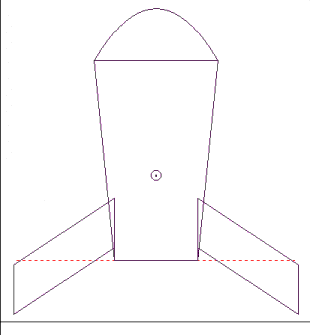
When you are satisfied with the fin alignment and nose weight, glue the lid to the cup, straw and tube using gel CA. Be careful not to torsion the launch lug straw .
Using an Estes 12" hex plastic chute for a pattern. (Pre-assembled by Far Eastern labor and sold at Wal-Mart is preferred.) Cut the smiley face out of the Wal-Mart bag. Affix paper reinforcing rings and shroud lines. Again, if you can't assemble a 12" chute, build a kit.
Install shock cord in body tube using your favorite method. I personally like the old Estes tri-fold. I used cheap Estes 1/8" elastic scavenged from my son's TidalWave® RTF® rocket. This rocket is so light and draggy that I don't expect much stress on the cord. The lack of a traditional nose cone should also reduce stress on the shock cord. I glued the shock cord mount 180º from the launch lug straw to try and prevent tangling that would snap off the straw. Tie a loop in the free end of the shock cord and attach the parachute shroud lines to the loop. I tied a bowline knot in the shock cord to make a loop. Then I passed the chute through the shroud lines. I shouldn't really have to tell you that part.
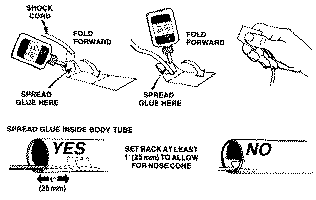
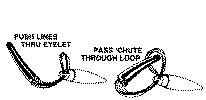
Launch Preparation:
Install Engine (B6-2, C6-3)
Fill (I mean fill) BT-50 with wadding leaving room only for shock cord and
chute. You don't want the air pressure and acceleration pushing everything to
the back and changing the CG in flight.
Carefully fold Wal-Mart bag chute very loosely. It should cover the entire
opening of the body tube.
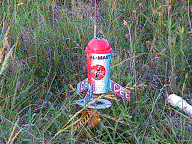
Help prepare your mind and soul for that which is M.OR.F.E.A.R. with an ICEE.
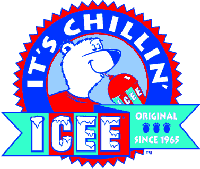
Death to Slurpees and Frozen Coke!!
Preflight concerns: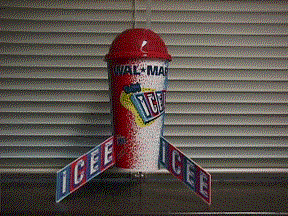
- Stability - It's always so tricky with short, stubby rockets.
- Shifting - Noseless design adds to concerns of parachute shifting and altering CG during flight.
- Memory - The plastic bag parachute material does not seem to inflate easily.
- Weather - It's been an endless winter in Arkansas (so much for global warming) and I want to fly my ICEE!
Flight Log:
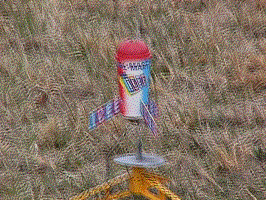 The first launch attempt
was with a B4-2. Apparently this motor was made completely of nozzle clay. All
attempts to light it were unsuccessful. Next up was a C6-3. The boost was 500'
straight up. Parachute deployed at apogee. While it was on the chute, the wind
shifted so that it was blowing out of the South across the short axis of our
flying field. M.O.R.F.E.A.R. landed just inside the park fence. I was unable to
catch any of the flight with the digital camera. The pad picture just before
the B4-2 debacle (right) will stand in history with "Goddard in the
Snow" as a high point in history for all the same wrong reasons. Boy, did
my hands shake at the launch. M.O.R.F.E.A.R. was recovered without damage. A
significant amount of debris was noted around the opening in the top.
The first launch attempt
was with a B4-2. Apparently this motor was made completely of nozzle clay. All
attempts to light it were unsuccessful. Next up was a C6-3. The boost was 500'
straight up. Parachute deployed at apogee. While it was on the chute, the wind
shifted so that it was blowing out of the South across the short axis of our
flying field. M.O.R.F.E.A.R. landed just inside the park fence. I was unable to
catch any of the flight with the digital camera. The pad picture just before
the B4-2 debacle (right) will stand in history with "Goddard in the
Snow" as a high point in history for all the same wrong reasons. Boy, did
my hands shake at the launch. M.O.R.F.E.A.R. was recovered without damage. A
significant amount of debris was noted around the opening in the top.
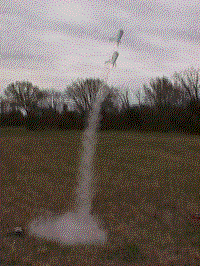 The winds
picked up as the afternoon progressed but the crowd grew surly with its demands
for another launch of the flying ICEE. The wind was still out of the South so
the launch rod was angled into the wind to aid recovery on our field. The C6-3
ejected just past apogee. The chute spun rapidly in the heavier winds and
performed a self reefing maneuver. M.O.R.F.E.A.R. came down hard on one fin,
cracking it about one third of the way down the fin. More debris was noted
around what has become know as "the blowhole". None of this mattered
to the onlookers who hooted and hollered with the abandon of NASCAR fans on
$0.25USD beer night. The presence of M.O.R.F.E.A.R. was so strong that it left
a double image in the photo of its second flight. (or the guy with the staggers
and jags was filming again)
The winds
picked up as the afternoon progressed but the crowd grew surly with its demands
for another launch of the flying ICEE. The wind was still out of the South so
the launch rod was angled into the wind to aid recovery on our field. The C6-3
ejected just past apogee. The chute spun rapidly in the heavier winds and
performed a self reefing maneuver. M.O.R.F.E.A.R. came down hard on one fin,
cracking it about one third of the way down the fin. More debris was noted
around what has become know as "the blowhole". None of this mattered
to the onlookers who hooted and hollered with the abandon of NASCAR fans on
$0.25USD beer night. The presence of M.O.R.F.E.A.R. was so strong that it left
a double image in the photo of its second flight. (or the guy with the staggers
and jags was filming again)
The residue on the dome of M.O.R.F.E.A.R. around the blowhole was easily removed with baby wipes. The fin was repaired with yellow glue and the joint was dry before the range was cleaned up. The parachute performed beautifully, the margin of stability was very good, and the launch lug straw above the dome was sufficiently durable for flight. I am extremely happy with the performance of this rocket. It is not the sport model that you're going to rack up 500 flights with, but it is a fun novelty rocket that's a real crowd pleaser.
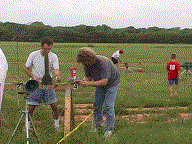 M.O.R.F.E.A.R. made the trip to "Native America" to fly with the
Tulsa Area Rocketry Association. After certifying level one with a crayon bank
rocket, I needed a little more odd-roc fun to round out the day. M.O.R.F.E.A.R.
drew the usual comments and questions. The straw launch lug is always a big
hit.
M.O.R.F.E.A.R. made the trip to "Native America" to fly with the
Tulsa Area Rocketry Association. After certifying level one with a crayon bank
rocket, I needed a little more odd-roc fun to round out the day. M.O.R.F.E.A.R.
drew the usual comments and questions. The straw launch lug is always a big
hit.
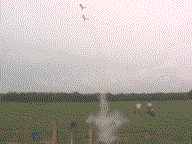 A
little windy again, but M.O.R.F.E.A.R. turned in a great damage free flight on
a C6-3. The usual crowd reaction of "that thing really does fly". I
have got to get a digital camera with a faster shutter speed. My lovely wife
took this photo and even she got a double launch picture. A lot of questions on
getting a cup to fly "right side up". I am currently building another
M.O.R.F.E.A.R. with a 24mm motor mount. This one will have 1/16" basswod
fins instead of balsa to ease my mind. I think future 18mm versions will also
use basswood. This is a terrific rocket and I plan to fly many variants in the
future. (Have you seen that awful green frozen stuff at Burger King? Hmmm.....)
A
little windy again, but M.O.R.F.E.A.R. turned in a great damage free flight on
a C6-3. The usual crowd reaction of "that thing really does fly". I
have got to get a digital camera with a faster shutter speed. My lovely wife
took this photo and even she got a double launch picture. A lot of questions on
getting a cup to fly "right side up". I am currently building another
M.O.R.F.E.A.R. with a 24mm motor mount. This one will have 1/16" basswod
fins instead of balsa to ease my mind. I think future 18mm versions will also
use basswood. This is a terrific rocket and I plan to fly many variants in the
future. (Have you seen that awful green frozen stuff at Burger King? Hmmm.....)
 I
just can't get enough of this goofy little rocket. I had to launch it Sunday
(05/13) evening in the vacant lot near my house. (The owner is very cool with
this.) There was no wind and I needed to see how M.O.R.F.E.A.R. performed with
no wind.
I
just can't get enough of this goofy little rocket. I had to launch it Sunday
(05/13) evening in the vacant lot near my house. (The owner is very cool with
this.) There was no wind and I needed to see how M.O.R.F.E.A.R. performed with
no wind.
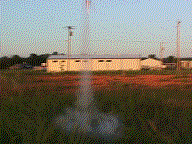 Well, here
are my massive launch photo inabilities on public display again. This flight is
on a B6-2. I wanted to make sure that this motor would fly well in this rocket.
Yeppers. It's fine. It had a beautiful straight up boost. I just knew it would
without the wind. The parachute streamered for just a moment before opening.
Gotta remember to add that talcum powder. Damage free recovery. Going to turn
it around and fly it again.
Well, here
are my massive launch photo inabilities on public display again. This flight is
on a B6-2. I wanted to make sure that this motor would fly well in this rocket.
Yeppers. It's fine. It had a beautiful straight up boost. I just knew it would
without the wind. The parachute streamered for just a moment before opening.
Gotta remember to add that talcum powder. Damage free recovery. Going to turn
it around and fly it again.
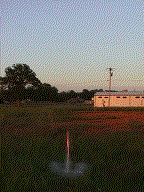 The standard
C6-3 did just fine. Talcum on the chute for a great opening. The ejection
charge scorched the straw launch lug a little just above the blowhole. Hmm. I
think I'll drink some more parts on the way to work tomorrow and get a stroon
(straw-spoon) upgrade for the launch lug and maybe paint a new flavor lid.
(Blue Raspberry is coming to mind as I type and drink ICEE.)
The standard
C6-3 did just fine. Talcum on the chute for a great opening. The ejection
charge scorched the straw launch lug a little just above the blowhole. Hmm. I
think I'll drink some more parts on the way to work tomorrow and get a stroon
(straw-spoon) upgrade for the launch lug and maybe paint a new flavor lid.
(Blue Raspberry is coming to mind as I type and drink ICEE.)
Sponsored Ads
 |
 |
